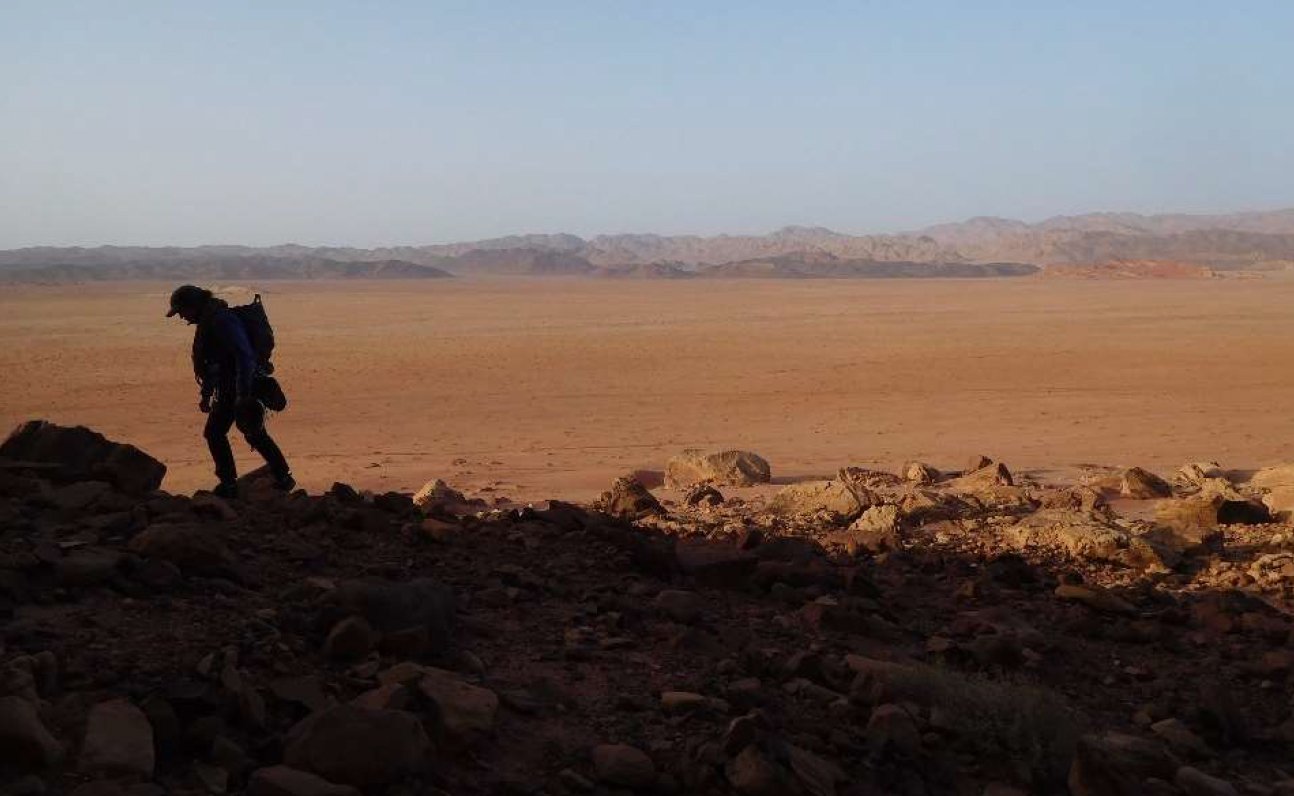
Trip Report: Jordan Trip 2019 by Todd Swain
We flew from Palm Springs to Salt Lake City on February 19th, the first leg of our journey to Amman, Jordan. Ultimately, our flight onward from Salt Lake City was delayed 24 hours due to a mechanical issue. As a result of the delay, we were also rerouted, which included an additional stop in London (Salt Lake-Paris-London-Amman). We arrived in Amman late on the 21st, sans one bag of climbing gear. The hotel we stayed at in Madaba, not too far from the airport, had graciously changed our reservation and we were greeted at 1am and shown to our room. The next morning, we met up with Henry Barber, an old friend from New Hampshire, who had spent the previous day touring the town because of our delay.
On the 22nd, we did the four-hour trip to Wadi Rum, and upon our arrival, were met by a local Bedouin, Awwad Sabboh. We stayed the next two nights at his house in the village of Wadi Rum. His compound has a main residence, a communal living room, a guest tent and a guest room. Adjacent to the guest room and tent is an enclosure with a dozen goats and sheep. About 100 yards away, is the mosque, which broadcasts the call to prayer morning and evening. The morning call to prayer causes the dogs of the neighborhood to whimper and the broadcast echoes off the huge sandstone walls.
Why Wadi Rum? Watching the movies Lawrence of Arabia with Peter O’Toole or more recently, The Martian with Matt Damon will provide the answer, whether you are a climber or not. The Wadi Rum Protected Area (a UNESCO World Heritage Site) has sandstone towers that shoot up out of the flat desert a thousand or more feet in height. The area is a climber’s paradise.
 Above: Typical Wadi Rum scene taken near Lawrence’s Well (as in Lawrence of Arabia).
Above: Typical Wadi Rum scene taken near Lawrence’s Well (as in Lawrence of Arabia).
Awaad’s family has lived in Wadi Rum for many generations. When we arrived, Awaad and his wife had four children and his wife was nine months pregnant. He asked us to guess how many siblings he had. I choose six and he replied “What do you think I am, European?” Awaad had 30 siblings from one father and three wives. We were told that in Bedouin culture, a man can have up to four wives and as many children as they can adequately care for. In querying other Bedouin, it seems the current generation is choosing to have one wife and three or four children.
Narrator switches to Donette’s voice: Awwad’s wife went into labor our second night there. As is done, he called the ambulance that comes from Aqaba, 45 minutes away and started driving toward Aqaba. His wife was transferred to the ambulance and Awwad followed to the hospital. His wife and baby son, Muhammad (Hammad for short) came home the next morning. That afternoon, Awwad and his extremely energetic 4-year-old daughter, Rose, came and asked me if I’d like to meet his wife and newborn. I was brought into the family’s gathering room, similar to many traditional Arab living rooms, a large carpeted rectangle surrounded with four-inch cushions and back rests on the floor, serving for gathering, dining, and sleeping. It was a bustling, happy, women-only scene! As I entered, all 20 or so women rose to greet me—even the new mom! (I somehow convinced her to not get up.) She and all the women were properly, festively dressed—no loosening of headscarves even in a women-only setting. The room was joyous, filled with chatter and children—three or four nursing at a time, the rest intent on chasing, playing, or snagging the candy-filled paper we were all presented with. Women came in throughout my hour there. Everyone stood for older women who joined us, even mom. At each entrance, the new visitor moved around the room, greeting one another with many kisses. I was serendipitously seated next to the village’s English teacher! She explained to me some of what I was seeing. The time for prayer came and most women left for the courtyard for a few minutes. The teacher told me that women on their period were not expected to pray as it wasn’t good for them. One of the older women, for whom getting up and down on the floor had been difficult, was brought a prayer rug and cushion and she quietly prayed in place. Everyone came back into the room and smartphones were lit up sharing pictures and jokes online, conversations taken up and the 2-year-old boy who had been eyeing my candy successfully absconded with it. I left as more women entered. This visiting was to go on for two days.
Back to Todd’s narration: Our first day climbing was on a rock formation near Awaad’s desert camp. The camp was a 20-minute drive out into the desert from the village. We did two first ascents on this cliff (a 200-foot 5.8 crack and a short 5.6 corner) and saw potential for more climbs. The next day we climbed on the massif that looms directly above the village, Jebel Rum. We did a highly recommended route called Goldfinger (5.9) and were really underwhelmed. I thought if this was the best Wadi Rum had to offer, what do we do for the next few weeks?

We then shifted our lodging to a desert camp run by another Bedouin, Khaled Aodh. He had been recommended to us by friends from Portland, Oregon and did not disappoint. Khaled was a climber and hence, knows where the remote climbs are located. On the 25th, we drove to within three kilometers of the Saudi
Arabian border to do a climb called The Haj (5.9, 600 feet [pictured above]). Once Khaled drove away (promising to return at 4pm), we were enveloped in the vastness of the desert. We were far enough from camp that if Khaled didn’t return, it would be a challenge to make it back alive. This setting was why we came to Jordan. As we ascended the route, we saw Bedouin goat herders moving their flock into Saudi Arabia (the Bedouin carry their passports with them and are allowed to wander back and forth across the border as they have done for generations). The descent from the climb was technical, involving dicey scrambling along narrow ledges and multiple rappels.
Khaled’s desert camp is one of perhaps 50 that have been established for tourists. It seems that most folks spend a single night and that we were the exception spending four. These camps have a series of small sleeping tents that surround a central dining/gathering tent. The camps also have a concrete block toilet building with flush toilets and solar heated showers. The experience is pretty nice; we’d call this “Glamping” (glamorous camping) in the US.
Staying with Khaled at his desert camp was peaceful and highly enjoyable. Each day we drove far out into the desert to a new climbing spot and on our return to camp, were taken to see natural arches, rock inscriptions (below) and other things of interest. Scattered throughout the desert are Bedouin living traditional lives herding camels, goats and sheep.

Above: 2,500-year-old rock art left by ancient caravans passing through Wadi Rum.

Above: Climbing Merlin’s Wand (5.10).
The forecast called for a big storm that was to include rain and possible snow. We returned to the village on the afternoon of the 28th by doing a great hike down through Rakabat Canyon. By the time we reached the village, the wind was howling and dust filled the air. The sandstorm was exactly what you have seen in the movies – very limited visibility, like a snowstorm in the Great Plains. We dropped our gear at Khaled’s house in the village and while waiting for a taxi, met his wife and four young boys.
We then took a taxi to the city of Aqaba, which is located about 45 minutes south of Wadi Rum village on the Red Sea. Henry left for Petra on the 29th and we have explored Aqaba, gotten laundry done and caught up on other errands. Our friend from Bulgaria, Marin Zagorchev, arrives in Aqaba this evening (March 3rd). We’ll return to Wadi Rum tomorrow for another ten days of climbing.
